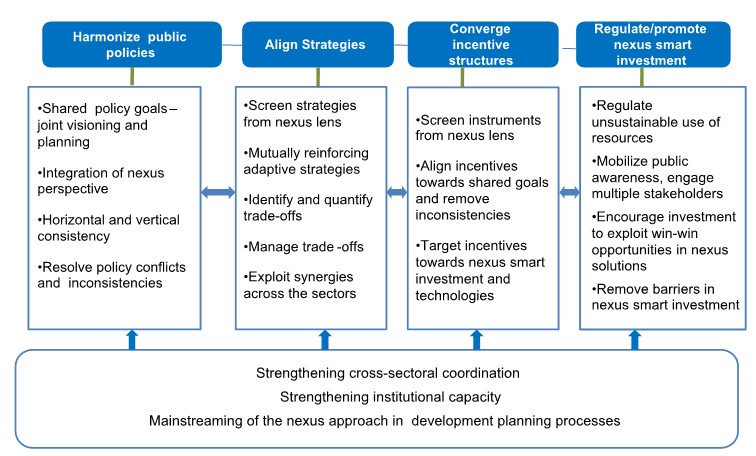5.4 Policy and Governance Instruments
Nexus Governance
We assume that inter-sectorial Nexus governance would lead to optimised resources management and hence improved overall welfare
→ However, Nexus governance measures can often not be implemented because of the existing single-sector governance system
→ Therefore, a clear policy framework is required that can foster sector integration
Important questions to ask are:
- What institution could assume such a task?
- How is it achieved?
The next Learning Unit will introduce you to governance instruments and related case studies. The following sections summarize some key instruments. Governance and Response measures to overcome Nexus conflicts and trade-offs should be based on a Nexus assessment. Effective responses require strategic vision, appropriate policies, regulations and an enabling institutional setting.
Responses should be designed at the appropriate scale: local, regional, national or transboundary. Selection of potential interventions should be supported by decision-making tools.
6.4.1 Policy Framework for Managing the Nexus
 Rasul, 2016
Rasul, 2016
Important points to consider for a policy framework that addresses the Nexus:
→ Horizontal (cross-sectoral) and vertical (between levels of government) coordination is essential.
→ Institutional relationships are to be considered
→ The capacities of local government institutions need to be strengthened
Different types of interventions can be used to manage the Nexus:
- Institutional policies to integrate the Nexus perspective
- Economic instruments to align incentives and exploit synergies
- Information generation and sharing among sectors to support integration
- Investments to exploit win-win opportunities
- Capacity development to strengthen institutional capacity
6.4.2 Vertical Coordination
- Dialogue processes and consultations
- Conferences of national and regional ministries (often along sectoral lines)
- Working groups between local-regional-national government levels
Vertical coordination between different levels is realised through various different mechanisms. Those listed on this section are only some of the examples available (and these examples often also have different names in different national contexts).
Dialogue processes and consultations can serve as strong mechanism for vertical integration by:
- Building relationships and trust between national and local actors
- Clarifying mandates, policies and institutional arrangements
- Identifying opportunities and obstacles for the implementation of national development targets and policies at the local level
- Facilitating coordinated representation of interests from the local to the national level
Continue to study questions Continue with next unit
References
GIZ (2017), ‘The Urban Nexus Guide - Module 3: Strengthening Horizontal and Vertical Governance Structures’, [Powerpoint presentation].
Rasul, G., 2016, Managing the food, water, and energy nexus for achieving the Sustainable Development Goals in South Asia, Environmental Development, Volume 18, Pages 14-25, https://doi.org/10.1016/j.envdev.2015.12.001
Scott, A. 2017. Making governance work for water–energy–food nexus approaches. Working Paper. London: Climate and Development Knowledge Network (CDKN), http://cdkn.org/wp-content/uploads/2017/06/Working-paper_CDKN_Making-governance-work-for-water-energy-food-nexus-approaches.pdf